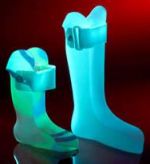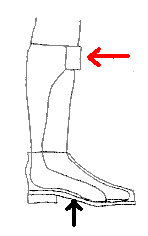|
| |
 
Traditional Ankle Foot Orthosis
Therapists often recommend, and physicians frequently prescribe the
ankle-foot orthosis (AFO) for patients with gait deviations that relate to
muscle weakness. The AFO substitutes for weak dorsiflexors during swing and,
more importantly, for weak plantar flexors during stance.
The AFO's effect on supporting the forefoot and preventing plantar flexion or
"foot drop" during swing is straightforward. Less obvious is the AFO's role as a
substitute for plantar flexor muscles. The plantar flexors must be active during
midstance and terminal stance to counter the dorsiflexor moment that is produced
by the ground reaction force. If the plantar flexors are weak, the ankle
dorsiflexes too rapidly and, because the lower extremity is positioned in a
closed chain, the knee flexes.
Midstance knee flexion threatens the person's stability. Someone with weak
plantar flexors must compensate, or must wear an external device (an orthosis)
that substitutes the force that the plantar flexors ordinarily provide.
When a person bears weight on an AFO that he or she wears inside the shoe, the
AFO's rigid walls transfer the ground reaction force (black arrow) in the
direction indicated by the red arrow. Thus, the AFO directs a force posteriorly
against the anterior tibia during midstance and terminal stance, and prevents or
controls tibial advancement. In this way, the AFO's force produces a plantar
flexion moment that counters the ground reaction force's (GRF) tendency to
dorsiflex the ankle.

|